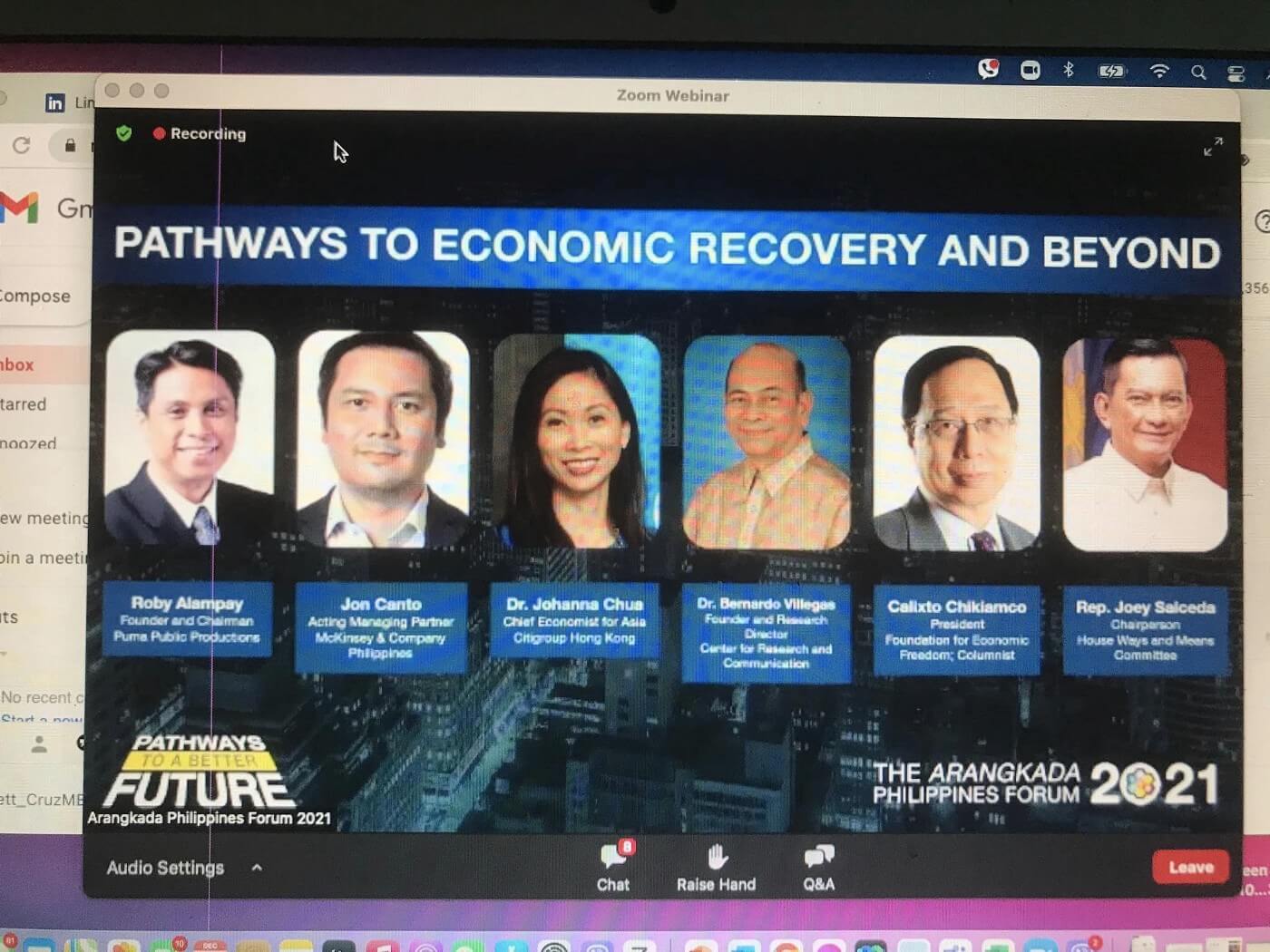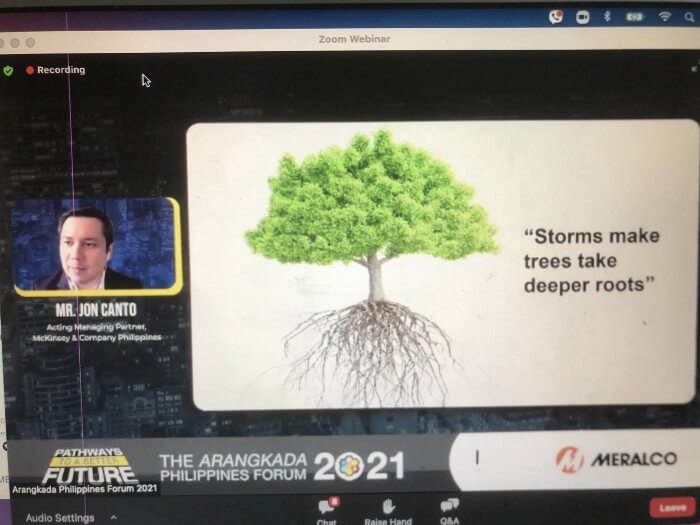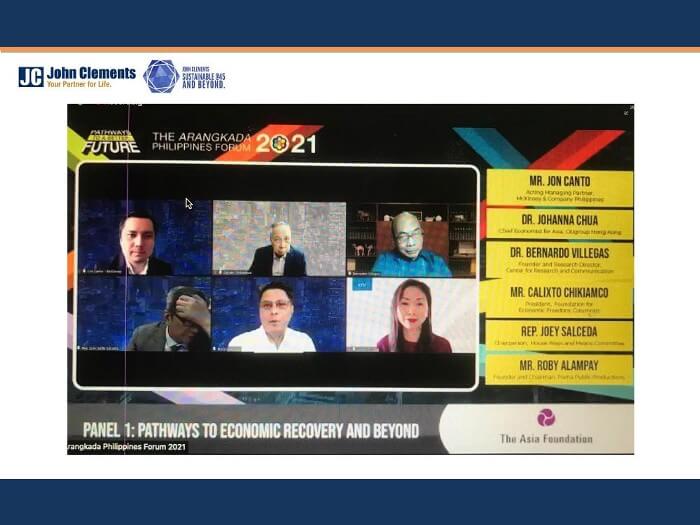On December 2, 2021, I was fortunate to attend the Arangkada Philippines panel session on Pathways to Economic Recovery and Beyond. It was moderated by Roby Alampay (Founder and Chairman of Puma Public Productions) and consisted of panelists Jon Camto (Acting Managing Partner, McKinsey and Co.), Dr. Johanna Chua (Chief Economist, Citigroup), Dr. Bernardo Villegas (Founder and Research Director, Center for Research and Communications), Mr. Calixto Chikiamco (Columnist and President, Foundation for Economic Freedom), and Rep. Joey Salceda (Chairperson, House Ways and Means Committee).

John Camto started the session by explaining that the goal of the panel was to share perspectives on potential pathways for the economic recovery of the Philippines. He mentioned that there is a widely accepted view that we need to build a better economy and come out of this pandemic stronger. He spoke about resilience and how the Philippines should position itself properly for that to happen. He said it is imperative to talk about how to prepare ourselves for the journey ahead as a country.

Jon Camto shared that when we look at the pandemic and our road to recovery, we typically have several scenarios correlated to public health response and economic response. As of the moment, the consensus is there will be ongoing virus recurrence with different variants emerging. The question now is, how do we recover economically? Do we expect longer-term recovery or shorter-term growth over time? Looking at where we stand today, the fearless forecast is — on the positive side — we get to a muted recovery, wherein we could go back to a GDP of pre-covid levels by the third quarter of next year. If the virus and the new variants persist, this could extend to the first quarter of 2023
Where will this recovery come from? Looking at the different sectors that comprise the majority of the country’s GDP, it will be from:
- Consumer Goods and Manufacturing — we still see a growth in the essential categories.
- Manufacturing — the Philippines has not been very strong in this space, but if we can only position ourselves to face upcoming developments in this industry, we could be one of the stronger players.
- Trade — there’s a big shift towards digital channels, e-commerce, and delivery.
- Real Estate and Construction — we expect that the pent-up demand will continue; on the real estate side, the growth will more likely come from residential and industrial segments.
- Financial Services — there’s a big shift to digital banking, which allows for a greater financial inclusion across the country.
- BPOs and OFWs (both major parts of our country’s GDP) — OFW remittances remain close to pre-covid levels; BPOs have grown despite the pandemic; both sectors will continue to grow.
- Energy Expansion
- Healthcare
Key trends we have seen that could be future growth engines for the Philippines and its neighboring countries include:
- Manufacturing
- Infrastructure — basic and green infrastructure
- Preparing our SMEs and consumers for a digitized future — research shows that for the last four years alone, the use of digital banking and e-wallets have increased seven-fold and two-fold, respectively; this started before COVID and was strengthened by COVID.
- Skills we require as a country to reskill and upskill — knowing the types of jobs and opportunities we will have in the future.
- How do we create value in our food and agriculture sector as a whole?
Jon Camto shared that there’s a broad understanding that foreign investment is really the enabler (in the long-term) to capture these opportunities. As it is, the Philippines’ FDI is relatively lower than a lot of our neighbors.
He ended his talk by posing several questions:
- How do we think about these challenges in structural positioning when it comes to attracting FDI and taking lessons from how other countries are doing it?
- What should be the priority sectors?
- What will drive growth?
- What will create jobs?
- Where can we compete and win?
- How do we proactively go after investments targeting specific companies?
The second person to speak was Dr. Johanna Chua of the Citigroup. She shared that she has been analyzing the challenges the Philippines is facing and what we can do. After two years of this COVID situation, we look at how the Philippines performed compared to other countries in Asia. We were one of the worst in terms of lost income. The good news, she said, is that we came into this crisis with a pretty strong private sector balance sheet. She commended the economic managers (BSP and the Finance Department) in terms of how well they steered and preserved a lot of the balance sheet strengths so that we are able to prevent significant risks and lasting damages. But in terms of how the Philippines managed the policies and the predictability of the policies in the pandemic, there’s a big question mark on whether the Philippines could have done better.
Dr. Chua said that she is proud and happy to see that the vaccination is slowly picking up. This is one of the most important steps to recovery, she shared. She further stated that it is a possibility that the Philippines will go back to pre-COVID levels of output by the end of 2022, but also reiterated that this is not enough. She cited that India and Indonesia have started to go back to pre-COVID level outputs, and China has already done this last year. This means that the Philippines has had almost two years of permanent loss of income and output. She said that a lot of people will come out of this worse off than where they were pre-COVID.
The question is not just whether we can get back to pre-COVID levels, but more of can we go back to pre-COVID levels of growth? In the last five years prior to the pandemic, the Philippines has been growing on an average of about 6.6%. Can we get back there? Dr. Chua explained that we really need a lot more reforms and policy actions before we even get there.
Dr. Chua also shared that China’s a very good warning for the Philippines. China, she said, got back to pre-pandemic levels of output in the third quarter of last year. They had a very short period of lost income and output and yet, a-year-and-a-half later, consumption growth in China has never gotten back to pre-COVID trend growth. So, if China has already been suffering from a lot of drags from this situation, what more for other countries that have taken longer to get back to pre-pandemic state? She said that we need to figure out the sources of economic scarring and how we can address these.
Dr. Bernardo Villegas started his short talk by saying that in the last three to four weeks, the mood has shifted from pessimistic to optimistic. It has been cited in a lot of venues that the Philippines will be the fastest-growing economy in SEA next year, with a GDP growing at 7.3%. If we take a look at the pre-pandemic years, despite the struggles from both the Aquino and Duterte administrations, we were still able to grow at 6–7% with existing deficiencies, such as restrictions against foreign direct investments and issues in global competitiveness. Dr. Villegas maintains that as we recover next year, we can still maintain the 6–7% growth over the next 3–5 years, as long as the next administration will just continue what the Aquino and Duterte administrations have done, which was to appoint capable people in their respective international economic agencies. Dr. Villegas agreed with Dr. Chua that we cannot just go back to normal. We have to accelerate our growth rate to about 8–10% in the next 5–10 years, somehow replicating what China and India were able to do.
So where will the purchasing power come from in the next three to five years? Dr. Villegas shared that this will still come from our overseas workers, explaining that the whole world discovered how much dependent they are on the young, growing, and English-speaking population of the Philippines.
Dr. Villegas shared his own perspectives on what should be done to achieve growth. He said that the first thing we should do is to focus on agriculture and food development. This will definitely introduce a high growth rate and address poverty issues as 75% of our population is in the rural areas. The second measure we can take is to make sure to accelerate the Build, Build, Build program. This is also where we badly need FDI. He said that the next administration must make sure to revisit the constitution and remove all restrictions.
Mr. Chikiamco was the next to speak and shared that the pandemic has also allowed some opportunities to develop, but the question is how to enable those opportunities. He agrees with amending the 1987 Constitution, especially those restrictions on FDI, particularly in telecoms and transport. He said that we should prioritize agriculture, emphasizing on the need to do agricultural reform. He further explained that it is unfortunate that we cannot take advantage of agricultural development unless we do a structural reform, which starts with the amendment of the 1987 Constitution. Mr. Chikiamco shared that we have to free the rural land market and promote agricultural business and commercial farming. We should also get the private sector very much involved in the education and reskilling of our people. He further shared that we have a lot of potentials in mining and forestry since the Philippines is a tropical country. The government has to change its policies in forestry to provide stable property rights so that investors can come in.
Rep. Salceda said that he was probably the most positive among the panelists. Being the last speaker, he had a short talk and merely reiterated the need to revisit the 1987 Constitution and how we should strive to lift the restrictions to FDI. He also shared that it is very important to start focusing on agriculture.

Key Takeaways:
- While we learned about our country’s growth, we still have to catch up in terms of wanting to remain competitive in the global market. And with the elections coming up, I believe it’s high time we choose a candidate that can make a significant impact on the factors presented — FDI, focus on agriculture, education, and digital transformation.
- If other countries can do it, we can do it too, as long as we have the right leaders in place.
- For John Clements, we have to be ready for what’s to come as the Philippine workforce reskills in terms of rapid automation and digitization.



